2. 青岛科技大学数理学院, 山东青岛 266061;
3. 中国科学院地质与地球物理研究所中国科学院地球与行星物理重点实验室, 北京 100029
2. College of Mathematics and Physics, Qingdao University of Science and Technology, Shandong Qingdao 266061, China;
3. CAS Key Lab of Earth and Planetary Physics, Institute of Geology and Geophysics, Chinese Academy of Sciences, Beijing 100029, China
在空间等离子体中,带电粒子之间的经典碰撞通常可以忽略不计,等离子体是无碰撞的.电子束流在这样的等离子体中普遍存在,它与太阳耀斑和地球磁层亚暴等空间爆发现象密切相关,可通过磁重联等物理过程加速形成(Lin and Hudson, 1971; Miller et al., 1997; Hoshino et al., 2001; Fu et al., 2006; Huang et al., 2010; Wang et al., 2010; Lu et al., 2010).电子束流可激发多种等离子体不稳定性,这些不稳定性可分为二类:电磁模和静电模.电磁模包括高频的哨声波和低频的阿尔芬波等(Gary and Feldman, 1977; Tokar et al., 1984; Markovskii and Hollweg, 2002; Mourenas et al., 2015; Gao et al., 2016; An et al., 2017),静电模包括朗缪尔波和电子束模等(Omura et al., 1996; Lu et al., 2005a, 2008).当然,静电模通过非线性相互作用可转化为电磁模,比如,通常认为太阳Ⅱ和Ⅲ型暴就是电子束流激发的朗缪尔波通过非线性相互作用转化为电磁模发射出来后被观测到的(Ginzburg and Zhelenyakov, 1958; Melrose, 1980; Cairns, 1987; Yoon, 1995).
本文关注的是电子束流激发的静电模.目前研究得比较多的静电模是朗缪尔波和电子束模.在由背景和束流电子组成的等离子体系统中,朗缪尔波的色散关系是(Lu et al., 2005a)

|
(1) |
其中ωr和k分别为朗缪尔波的频率和波数,ωpc=




|
(2) |
其中ub是束流电子的整体漂移速度,ne0=nc0+nb0是电子总密度.在电子束模的线性演化阶段形成的单色波,在其非线性的演化阶段波和波之间会互相合并,直至最后形成几个孤立的静电结构(Lu et al., 2005a, 2005b).在这种孤立静电结构中,电场呈双极结构,电子在相空间中是一个空洞,所以也称为电子相空间空洞,简称电子空洞(Bernstein et al., 1957; Omura et al., 1996; Muschiett et al., 1999; Chen et al., 2005; Lu et al., 2005b;Wu et al., 2010a, 2010b).这种电子空洞可形成于磁重联的分离线附近、激波的波前、地球的极区和磁尾,甚至磁鞘和太阳风中(Matsumoto et al., 1994; Bale et al., 1998; Ergun et al., 1998; Franz et al., 1998; Cattell et al., 2002; Pickett et al., 2004; Fujimoto and Machida, 2006; Huang et al., 2014).
除朗缪尔波和电子束模外,还有一种静电波是电子声波,它往往存在于由具有不同温度的两种电子成分构成的离子体系统中(Fried and Gould, 1961; Koen et al., 2012),因而较少得到关注.Gary和Tokar(1985)比较系统地研究了电子声波,他们从理论上分析了这支波存在的条件是温度较高的热电子的温度是温度较低的冷电子的10倍以上,并且热电子的密度相比较冷电子不能忽略(Gary and Tokar, 1985).而在空间等离子体中,束流电子的温度往往较背景电子高.比如在磁重联的分离线附近,在重联的X点区域加速的电子到达分离线附近后和背景电子有一较大的相对速度,同时这些束流电子往往温度很高(Huang et al., 2014).本文将通过一维静电粒子模拟研究束流电子温度远大于背景电子时电子束流激发的电子声波.
1 静电粒子模拟模型一维静电粒子模拟忽略了磁场的影响,采用周期边界条件.等离子体由背景和束流电子两种成份组成.这里离子不动,也即将其质量看成无穷大,它们只是提供了具有正电荷的背景.关于此程序的细节可参见(Lu and Cai, 2001).背景电子和束流电子的速度分布都满足麦克斯韦分布,不同的是束流电子有一整体漂移速度ub.背景电子和束流电子的温度分别是Tc和Tb,而其热速度分别是vTc和vTb.总的电子数密度为ne0=nc0+nb0,其中nc0、nb0分别是背景电子和束流电子的数密度.假定等离子体不稳定性激发的波动传播方向沿着束流电子的漂移速度方向.
在数值模拟中,电子的速度和密度通过ne0和背景电子的热速度vTc归一化,空间和时间通过冷电子的德拜长度λDc=(ε0kBTc/nc0e2)1/2和对应于总电子密度的等离子体频率倒数ωpe-1=(n0e2/meε0)-1/2来归一化,电场的归一化单位是meωpevTc/e.在模拟中,网格距为λDc,总共有1024个网格,时间步长为0.02ωpe-1.每个网格里平均来讲背景电子和热电子各有400个.
2 数值模拟结果系统地研究了束流电子和背景电子的温度比Tb/Tc、束流电子和背景电子的密度比nb0/nc0、束流电子漂移速度ub/vTc等因素对电子束流不稳定性激发的静电波的影响.这些算例的参数见表 1.所取的参数范围内,电子束流不稳定性激发的主要是电子声波,也有比较弱的朗缪尔波被激发,这两支波动都是沿着磁场传播的,所以我们可以用一维的静电程序(仅保留磁场的方向,磁场的影响可以忽略).
|
|
表 1 电子束流不稳定性的参数 Table 1 The parameters of electron beam instability |
该等离子体系统的介电函数可以写成如下表达式:

|
(3) |
其中,ω=ωr+iγ,ωr是等离子体波动的频率,γ是对应的增长率,k为等离子体波动的波数.λDc=







|
(4) |
其中ωpc=(nc0e2/meε0)1/2是对应背景电子的等离子体频率.公式(4)是等离子体中电子声波的色散关系(Gary and Tokar, 1985; Lu et al., 2005a),所以背景电子的热速度远小于束流电子的漂移速度,而束流电子的热速度远大于束流电子的漂移速度时,电子束流激发的是电子声波.
首先分析算例1的结果.图 1描绘了算例1中电场强度Ex2随时间的演化.从图 1中可以看出,电子束流不稳定的演化有两个阶段,大约20ωpe-1之前是线性增长阶段,之后电场强度Ex2达到饱和,约为0.04(meωpevTc/e)2,其值保持相对稳定.图 2是算例1中通过对电场Ex在时间和空间上进行二维的傅里叶分析得到的等离子体波动的色散关系,另外在图 2中还画出了通过公式(4)和(1)得到的电子声波和朗缪尔波的色散关系.可以看出数值模拟得到的等离子体波动的频率和波数集中在公式(4)得到的电子声波的色散关系处,表明电子束流激发的主要是电子声波,其主体的频率在0.5~0.7ωpe范围内.此外,在公式(1)得到的朗缪尔波的色散关系处,也可以发现微弱的波动存在,表明温度远高于背景电子的束流电子除可激发电子声波外,还可激发微弱的朗缪尔波.此外,需要说明的是,在本算例及其他算例中,根据线性理论得到的电子声波色散关系(公式(4))都略为在数值模拟得到的色散关系下面一点.导致这一点的原因可能是在通过线性理论得到公式(4)时,假定了背景电子的热速度远小于束流电子的漂移速度,而束流电子的热速度远大于束流电子的漂移速度,并且它们的速度分布是麦克斯韦分布情况下得到的.此外,公式(4)也没有考虑非线性的修正,这些都会导致我们的数值模拟结果和色散曲线公式(4)有偏差.
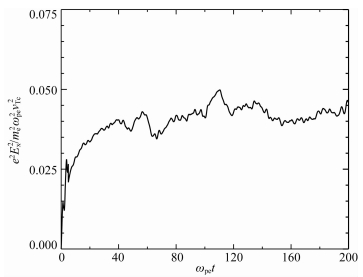
|
图 1 算例1中电场强度Ex2随时间的演化 Fig. 1 The time evolution of the amplitude of electric field Ex2 in Run 1 |
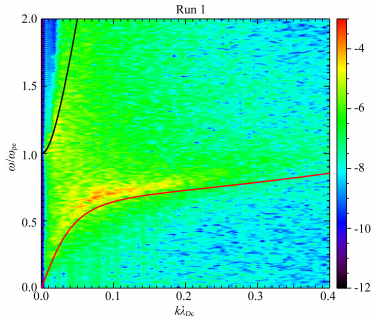
|
图 2 算例1中通过对电场Ex在时间(从ωpet=0~400)和空间上进行二维的傅里叶分析得到的等离子体波动的色散关系(其中红线是电子声波,黑线是朗缪尔波),图中的色标代表是的对应的电场强度(eEx/meωpevTc)2. Fig. 2 The dispersion relation of plasma waves obtained by Fourier transforming the electric field Ex in time (from ωpet=0~400) and space in Run 1 (where the red line plots the dispersion relation of electron acoustic waves, and black line plots the dispersion relation of Langmuir waves), the color bars represent the amplitude of the electric field (eEx/meωpevTc)2. |
图 3是算例1中ωpet=12、100和500三个时刻的电场Ex、背景电子和束流电子在(x, vx)相空间中的分布.其中ωpet=12是在不稳定性的线性增长阶段,而ωpet=100和500是在不稳定性的饱和阶段.对于束流电子而言,其在相空间的分布随着波动的激发没有明显的变化.对于背景电子而言,在等离子体波动的线性增长阶段,可以看到部分背景电子可以被激发的波动所捕获,而在波动的非线性演化阶段,部分背景冷电子可以被加速到很高的能量.这是由于激发的电子声波是有色散的,不同频率电子声波的相速度不同,通过和有色散电子声波的非线性相互作用可以将电子加速到很高能量.
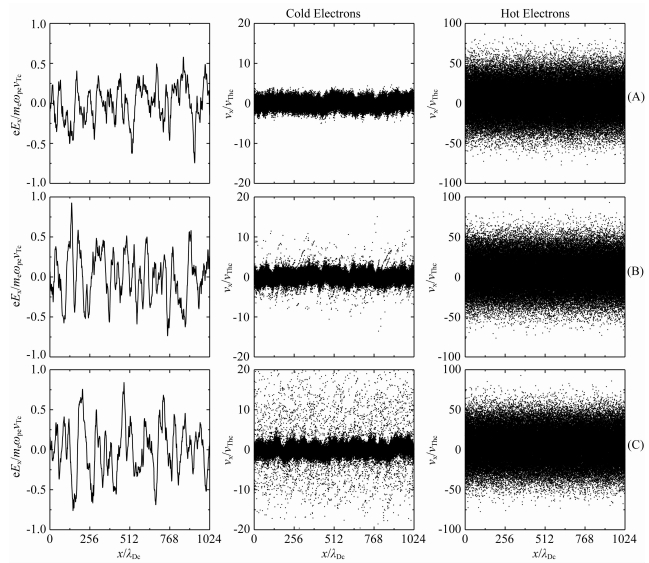
|
图 3 算例1中ωpet=12、100和500三个时刻的电场Ex、背景电子和束流电子的在(x, vx)相空间中的分布图 Fig. 3 The electric field Ex, x-vx phase-space plots for background and beam electrons at ωpet=12, 100 and 500 in Run 1 |
文中还计算了束流电子的温度、束流电子与背景电子的相对密度和束流电子的漂移速度对电子束流不稳定性的影响.图 4是算例1、2和3中电场强度Ex2随时间的演化.可以看出随着束流电子温度的降低,所激发的波动的线性增长率和饱和值都会降低.在这几个算例中,线性增长阶段都维持了大约20ωpe-1,而饱和后的电场强度Ex2分别约为0.04(meωpevTc/e)2,0.015(meωpevTc/e)2和0.01(meωpevTc/e)2.图 5是算例2和3中通过对电场Ex在时间和空间上进行二维的傅里叶分析得到的等离子体波动的色散关系,另外在图 5中还画出了通过公式(4)和(1)得到的电子声波和朗缪尔波的色散关系.可以看出,激发的波动主要还是电子声波,并且其主体的频率都是在0.5~0.7ωpe范围内.但是随着束流电子温度的降低,所激发的波动的幅度也降低.

|
图 4 算例1、2和3中电场强度Ex2随时间的演化 Fig. 4 The time evolution of the amplitude of electric field Ex2 in Run 1, 2 and 3 |
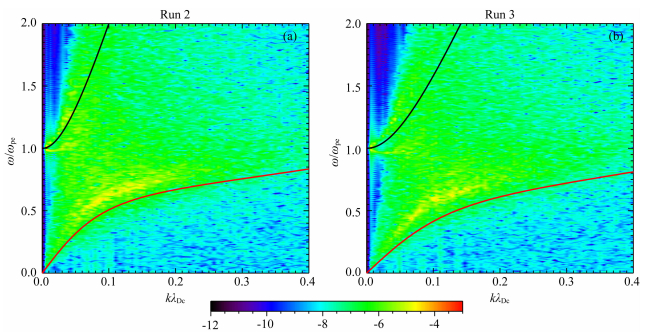
|
图 5 算例2和3中通过对电场Ex在时间(从ωpet=0-400)和空间上进行二维傅里叶分析得到的等离子体波动的色散关系(其中红线是电子声波,黑线是朗缪尔波),色标代表对应的电场强度(eEx/meωpevTc)2 Fig. 5 The dispersion relation of plasma waves obtained by Fourier transforming the electric field Ex in time (from ωpet=0~400) and space in Run 2 and 3 (where the red lines plot the dispersion relation of electron acoustic waves, and black lines plot the dispersion relation of Langmuir waves), the color bars represent the amplitude of the electric field (eEx/meωpevTc)2 |
图 6是算例4、5、6和7中电场强度Ex2随时间的演化.可以看出随着束流电子密度的降低,激发的波动的线性增长率和饱和值都会降低.在这几个算例中,线性增长阶段都维持了大约10ωpe-1,而饱和后的电场强度Ex2分别约为0.055(meωpevTc/e)2,0.055(meωpevTc/e)2,0.03(meωpevTc/e)2和0.02(meωpevTc/e)2.图 7是算例4、5、6和7中通过对电场Ex在时间和空间上进行二维傅里叶分析得到的等离子体波动的色散关系,同时给出了通过公式(4)和(1)得到的电子声波和朗缪尔波的色散关系.激发的波动主要还是电子声波,随着束流电子温度的降低,所激发的波动幅度会降低,但其主体的频率会增加.

|
图 6 算例4、5、6和7中电场强度Ex2随时间的演化 Fig. 6 The time evolution of the amplitude of electric field Ex2 in Run 4, 5, 6 and 7 |
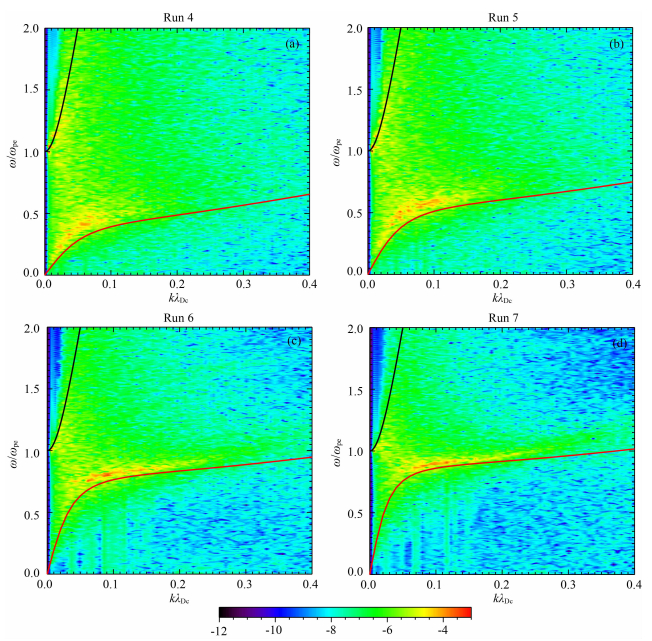
|
图 7 算例4、5、6和7中通过对电场Ex在时间(从ωpet=0-400)和空间上进行二维的傅里叶分析得到的等离子体波动的色散关系(其中红线是电子声波,黑线是朗缪尔波),色标代表是的对应的电场强度(eEx/meωpevTc)2 Fig. 7 The dispersion relation of plasma waves obtained by Fourier transforming the electric field Ex in time (from ωpet=0-400) and space in Run 4, 5, 6 and 7(where the red lines plot the dispersion relation of electron acoustic waves, and black lines plot the dispersion relation of Langmuir waves), the color bars represent the amplitude of the electric field (eEx/meωpevTc)2 |
图 8是算例8、9和10中电场强度Ex2随时间的演化.可以看出随着束流电子的漂移速度的增加,激发的波动的线性增长率和饱和值都会增加.在这几个算例中,线性增长阶段都维持了大约80ωpe-1,而饱和后的电场强度Ex2分别约为0.06(meωpevTc/e)2,0.06(meωpevTc/e)2和0.17(meωpevTc/e)2.图 9是算例8、9和10中通过对电场Ex在时间和空间上进行二维傅里叶分析得到的等离子体波动的色散关系,图中还给出了通过公式(4)和(1)得到的电子声波和朗缪尔波的色散关系.可以发现,激发电子声波的主体频率波动幅度0.4~0.7ωpe范围内,其幅度随束流电子漂移速度的增加而增加.

|
图 8 算例8、9和10中电场强度Ex2随时间的演化 Fig. 8 The time evolution of the amplitude of electric field Ex2 in Run 8, 9 and 10 |

|
图 9 算例8、9和10中通过对电场Ex在时间(从ωpet=0-400)和空间上进行二维的傅里叶分析得到的等离子体波动的色散关系(其中红线是电子声波,黑线是朗缪尔波),色标代表对应的电场强度(eEx/meωpevTc)2 Fig. 9 The dispersion relation of plasma waves obtained by Fourier transforming the electric field Ex in time (from ωpet=0-400) and space in Run 8, 9 and 10 (where the red lines plot the dispersion relation of electron acoustic waves, and black lines plot the dispersion relation of Langmuir waves), the color bars represent the amplitude of the electric field (eEx/meωpevTc)2. |
本文通过一维的静电粒子模拟程序研究了束流电子的温度远大于背景电子温度情形下的电子束流不稳定性,得到的主要结论如下:
(1) 所激发的波动主要是电子声波,电子声波可通过非线性相互作用将背景比较冷的部分电子加速到很高的能量;
(2) 束流电子温度的降低导致所激发的电子声波的线性增长率和饱和幅度降低;
(3) 束流电子和背景电子的相对密度的降低会降低电子声波的线性增长率和饱和幅度,并且波动的主体频率也会降低;
(4) 束流电子的漂移速度的增加会增加电子声波的线性增长率和饱和幅度.
电子束流是空间等离子体中非常普遍的现象,除可激发朗缪尔波和电子束模外,我们的研究表明,当电子束流的温度远大于背景电子的温度时,电子束流激发的是电子声波,电子声波有着较宽的频谱,并可加速/加热背景冷电子.在空间等离子体中经常可观测到宽频的静电噪声,频率从低向高可达到等离子体频率(Gurnett and Frank, 1977; Lin et al., 1984; Matsumoto et al., 1994), 以前一般认为静电孤立结构导致了这种宽频静电噪声(Matsumoto et al., 1994).在本文中发现,电子束流激发的电子声波一样有着很宽的频谱,因此,它提供了解释空间等离子体中观测到的宽频静电噪声的另一种可能性.
此外,本文数值模拟采用的周期边界条件,等离子体从计算区域的一端出去后会从另一端进来,相应于认为电子束流长度是无限长的.而在通常的空间等离子体中,电子束流是有限长的,但是其长度要远远大于激发波动的波长,除在束流前段约ubτN的范围内(其中τN是电子声波的非线性增长时间,在我们的算例中,τN~10ωpe-1),其他的地方波动都会有充分的时间进行非线性波粒相互作用,和用周期边界条件得到的计算结果是类似的.
An X, Bortnik J, Van Compernolle B, Decyk V, et al. 2017. Electrostatic and whistler instabilities excited by an electron beam. Physics of Plasmas, 24(7): 072116. DOI:10.1063/1.4986511 |
Bale S D, Kellogg P J, Larsen D E, et al. 1998. Bipolar electrostatic structures in the shock transition region:Evidence of electron phase space holes. Geophysical Research Letters, 25(15): 2929-2932. DOI:10.1029/98GL02111 |
Bernstein I B, Greene J M, Kruskal M D. 1957. Exact nonlinear plasma oscillations. Physical Reviews, 108(3): 546-550. DOI:10.1103/PhysRev.108.546 |
Cairns I H. 1987. Fundamental plasma emission involving ion sound waves. Journal of Plasma Physics, 38(2): 169-178. DOI:10.1017/S0022377800012496 |
Cattell C, Crumley J, Dombeck J, et al. 2002. Polar observations of solitary waves at the Earth's magnetopause. Geophysical Research Letters, 29(5): 1065. DOI:10.1029/2001GL014046 |
Chen L J, Pickett J, Kintner P, et al. 2005. On the width-amplitude inequality of electron phase space holes. Journal of Geophysical Research:Space Physics, 110(A9): A09211. DOI:10.1029/2005JA011087 |
Ergun R E, Carlson C W, McFadden J P, et al. 1998. Debye-scale plasma structures associated with magnetic-field-aligned electric fields. Physical Review Letters, 81(4): 826-829. DOI:10.1103/PhysRevLett.81.826 |
Franz J R, Kintner P M, Pickett J S. 1998. POLAR observations of coherent electric field structures. Geophysical Research Letters, 25(8): 1277-1280. DOI:10.1029/98GL50870 |
Fried B D, Gould R W. 1961. Longitudinal ion oscillations in a hot plasma. Physics of Fluids, 4(1): 139-147. DOI:10.1063/1.1706174 |
Fu X R, Lu Q M, Wang S. 2006. The process of electron acceleration during collisionless magnetic reconnection. Physics of Plasmas, 13(1): 012309. DOI:10.1063/1.2164808 |
Fujimoto K, Machida S. 2006. A generation mechanism of electrostatic waves and subsequent electron heating in the plasma sheet-lobe boundary region during magnetic reconnection. Journal of Geophysical Research:Space Physics, 111(A9): A09216. DOI:10.1029/2005JA011542 |
Gao X L, Mourenas D, Li W, et al. 2016. Observational evidence of generation mechanisms for very oblique lower band chorus using THEMIS waveform data. Journal of Geophysical Research:Space Physics, 121(7): 6732-6748. DOI:10.1002/2016JA022915 |
Gary S P, Feldman W C. 1977. Solar wind heat flux regulation by the whistler instability. Journal of Geophysical Research:Space Physics, 82(7): 1087-1094. DOI:10.1029/JA082i007p01087 |
Gary S P, Tokar R L. 1985. The electron-acoustic mode. Physics of Fluids, 28(8): 2439. DOI:10.1063/1.865250 |
Ginzburg V L, Zhelezniakov V V. 1958. On the possible mechanisms of sporadic solar radio emission (Radiation in an Isotropic Plasma). Soviet Astronomy, 2: 653. |
Gurnett D A, Frank L A. 1977. A region of intense plasma wave turbulence on auroral field line. Journal of Geophysical Research, 82(7): 1031-1050. DOI:10.1029/JA082i007p01031 |
Hoshino M, Mukai T, Terasawa T, et al. 2001. Suprathermal electron acceleration in magnetic reconnection. Journal of Geophysical Research:Space Physics, 106(A11): 25979-25998. DOI:10.1029/2001JA900052 |
Huang C, Lu Q M, Wang S. 2010. The mechanisms of electron acceleration in antiparallel and guide field magnetic reconnection. Physics of Plasmas, 17(7): 072306. DOI:10.1063/1.3457930 |
Huang C, Lu Q M, Wang P R, et al. 2014. Characteristics of electron holes generated in the separatrix region during antiparallel magnetic reconnection. Journal of Geophysical Research:Space Physics, 119(8): 6445-6454. DOI:10.1002/2014JA019991 |
Koen E J, Collier A B, Maharaj S K. 2012. Particle-in-cell simulations of beam-driven electrostatic waves in a plasma. Physics of Plasmas, 19(4): 042101. DOI:10.1063/1.3695402 |
Lin C S, Burch J L, Shawhan S D, et al. 1984. Correlation of auroral hiss and upward electron beams near the polar cusp. Journal of Geophysical Research:Space Physics, 89(A2): 925-935. DOI:10.1029/JA089iA02p00925 |
Lin R P, Hudson H S. 1971. 10~100 keV electron acceleration and emission from solar flares. Solar Physics, 17(2): 412-435. DOI:10.1007/BF00150045 |
Lu Q M, Cai D S. 2001. Implementation of parallel plasma particle-in-cell codes on PC cluster. Computer Physics Communications, 135(1): 93-104. DOI:10.1016/S0010-4655(00)00227-7 |
Lu Q M, Wang S, Dou X K. 2005a. Electrostatic waves in an electron-beam plasma system. Physics of Plasmas, 12(7): 072903. DOI:10.1063/1.1951367 |
Lu Q M, Wang D Y, Wang S. 2005b. Generation mechanism of electrostatic solitary structures in the Earth's auroral region. Journal of Geophysical Research:Space Physics, 110(A3): A03223. DOI:10.1029/2004JA010739 |
Lu Q M, Lembege B, Tao J B, et al. 2008. Perpendicular electric field in two-dimensional electron phase-holes:A parameter study. Journal of Geophysical Research:Space Physics, 113(A11): A11219. DOI:10.1029/2008JA013693 |
Lu QM, Huang C, Xie J L, et al. 2010. Features of separatrix regions in magnetic reconnection:Comparison of 2-D particle-in-cell simulations and Cluster observations. Journal of Geophysical Research:Space Physics, 115(A11): A11208. DOI:10.1029/2010JA015713 |
Markovskii S A, Hollweg J V. 2002. Electron heat flux instabilities in coronal holes:Implications for ion heating. Geophysical Research Letters, 29(17): 1843. DOI:10.1029/2002GL015189 |
Matsumoto H, Kojima H, Miyatake T, et al. 1994. Electrostatic solitary waves (ESW) in the magnetotail:BEN wave forms observed by GEOTAIL. Geophysical Research Letters, 21(25): 2915-2918. DOI:10.1029/94GL01284 |
Melrose D B. 1980. The emission mechanisms for solar radio bursts. Space Science Reviews, 26(1): 3-38. DOI:10.1007/BF00212597 |
Miller J A, Cargill P J, Emslie A G, et al. 1997. Critical issues for understanding particle acceleration in impulsive solar flares. Journal of Geophysical Research:Space Physics, 102(A7): 14631-14660. DOI:10.1029/97JA00976 |
Mourenas D, Artemyev A V, Agapitov O V, et al. 2015. Very oblique whistler generation by low-energy electron streams. Journal of Geophysical Research:Space Physics, 120(5): 3665-3683. DOI:10.1002/2015JA021135 |
Muschietti L, Ergun R E, Roth I, et al. 1999. Phase-space electron holes along magnetic field lines. Geophysical Research Letters, 26(8): 1039-1096. DOI:10.1029/1999GL900065 |
Omura Y, Matsumoto H, Miyake T, et al. 1996. Electron beam instabilities as generation mechanism of electrostatic solitary waves in the magnetotail. Journal of Geophysical Research:Space Physics, 101(A2): 2685-2698. DOI:10.1029/95JA03145 |
Pickett J S, Chen L J, Kahler S W, et al. 2004. Isolated electrostatic structures observed throughout the Cluster orbit:Relationship to magnetic field strength. Annales Geophysicae, 22(7): 2515-2523. DOI:10.5194/angeo-22-2515-2004 |
Pottelette R, Ergun R E, Treumann R A, et al. 1999. Modulated electron-acoustic waves in auroral density cavities:FAST observations. Geophysical Research Letters, 26(16): 2629-2632. DOI:10.1029/1999GL900462 |
Tokar R L, Gurnett D A, Feldman W C. 1984. Whistler mode turbulence generated by electron beams in Earth's bow shock. Journal of Geophysical Research:Space Physics, 89(A1): 105-114. DOI:10.1029/JA089iA01p00105 |
Wang R S, Lu Q M, Huang C, et al. 2010. Multispacecraft observation of electron pitch angle distributions in magnetotailreconnection. Journal of Geophysical Research:Space Physics, 115(A1): A01209. DOI:10.1029/2009JA014553 |
Wu M Y, Lu Q M, Huang C, et al. 2010a. Transverse instability and perpendicular electric field in two-dimensional electron phase-space holes. Journal of Geophysical Research:Space Physics, 115(A10): A10245. DOI:10.1029/2009JA015235 |
Wu M Y, Wu H, Lu Q M, et al. 2010b. Effects of perpendicular thermal velocities on the transverse instability in electron phase space holes. Chinese Physics Letters, 27(9): 095201. DOI:10.1088/0256-307X/27/9/095201 |
Yoon P H. 1995. Plasma emission by a nonlinear beam instability. Physics of Plasmas, 2(2): 537. DOI:10.1063/1.870979 |
 2018, Vol. 61
2018, Vol. 61


